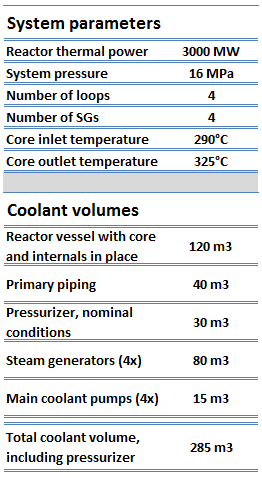Volume of Coolant in Reactor Coolant System

Source: gidropress.podolsk.ru
used with permission of АО ОКБ “ГИДРОПРЕСС”
In typical modern pressurized water reactors (PWRs), the Reactor Coolant System (RCS), shown in the figure, consists of:
- the reactor vessel, which contains the nuclear fuel
- four parallel heat transfer loops connected to a reactor vessel.
- each loop contains a main coolant pump and a steam generator.
- the system includes a pressurizer and its auxiliary systems
All RCS components are located inside the containment building.
At normal operation, there is a compressed liquid water inside the reactor vessel, loops and steam generators. The pressure is maintained at approximately 16MPa. At this pressure water boils at approximately 350°C (662°F). Inlet temperature of the water is about 290°C (554°F). The water (coolant) is heated in the reactor core to approximately 325°C (617°F) as the water flows through the core. As it can be seen, the reactor contains approximately 25°C subcooled coolant (distance from the saturation).
Volumes of typical PWR are in the following table.
It is an illustrative example, following data do not correspond to any reactor design.
It must be noted the volume of coolant significantly changes with the temperature of the coolant. The total mass of the coolant remains always the same, a change in water volume is not a change in water inventory. The reactor coolant volume changes with temperature because of changes in density. Most substances expand when heated and contract when cooled. However, the amount of expansion or contraction varies, depending on the material. This phenomenon is known as thermal expansion. The change in volume of a material which undergoes a temperature change is given by following relation:
where ∆T is the change in temperature, V is the original volume, ∆V is the change in volume, and αV is the coefficient of volume expansion.

The volumetric thermal expansion coefficient for water is not constant over the temperature range and increases with the temperature (especially at 300°C), therefore the change in density is not linear with temperature (as indicated in the figure).
See also: Steam Tables
At normal conditions the total volume of coolant in the reactor coolant system is almost constant. On the other hand, during transient load conditions the volume can significantly change. These changes are naturally reflected in a change in pressurizer water level. When the average temperature of reactor coolant goes gradually down, the total water volume is also decreasing, which lowers the pressurizer level. On a gradual load pick-up, the increase in reactor coolant average temperature causes the total water volume to expand, which raises the pressurizer level. These effects must be controlled by pressurizer level control system.
We hope, this article, Volume of Coolant in Reactor Coolant System, helps you. If so, give us a like in the sidebar. Main purpose of this website is to help the public to learn some interesting and important information about thermal engineering.
